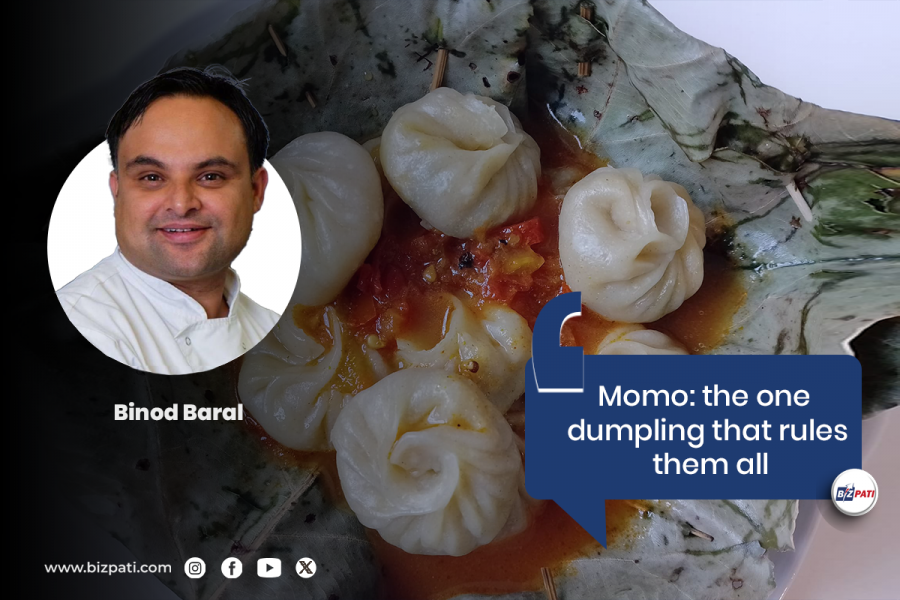
Binod Baral
The Momo's journey is a testament to the
resilience of the Nepalese Newar traders and the universal appeal of these
flavourful dumplings. Whether enjoyed in the vibrant streets of Kathmandu, the
misty hills of Darjeeling, or the cosmopolitan neighbourhoods of Queens, New
York, and street of Australia. The Momo continues to assert its supremacy as
the "King of Dumplings." It’s remarkable odyssey exemplifies the
power of food to transcend borderless cooking and unite people in the joy of
culinary exploration.
In the world of dumplings, one stands tall
as the unrivalled monarch of flavour and delight—the Momo. Often heralded as
the "King of Dumplings," the Momo has an illustrious journey from its
Tibetan origins to becoming a global culinary sensation. Its story is one that
unites cultures, tantalizes taste buds, and brings people together.
Momo's Origin:
Momo is a meat dumpling. Everyone has their
style of momo cooking; arguments can perhaps best be avoided. People often
wonder where momo originated. There is no doubt that momo originated in
Northeastern in China.
The word "Momo" means steam bun
in the Shaanxi language. This province was a gateway to northwest China along
the Silk Road. Still today, it is famous for tourists to visit. You cannot travel
through the northwestern area without being tempted by these delicious juicy
dumplings. Each city has its own variation. Some make dough thicker, and some
are finer and more elaborately twisted at the top. Meat-filled dumplings and
buns are the most popular snack, usually accompanied by tea in the tea houses.
It is a trendy dish to make during the
Chinese New Year. I personally love to make in friends and families gathering
so each one can take part in momo making where is your expert is and chit and chat,
share conversation and enjoy of making and eating.
The momo story begins in Tibet, where
locals cherished these small, Savory dumplings. What started as a regional
delight would soon transcend borders and evolve into various delectable forms
across diverse cuisines. Momo is indeed a delightful and popular dish, but
there is some discrepancy in your description regarding its origin. Momo is
most commonly associated with Tibetan and Nepalese cuisine, rather than
Northeastern China. While there are various types of dumplings and steamed buns
in Chinese cuisine, the term "momo" is typically used to refer to the
dumplings found in the Himalayan regions.
The origins of momo are more likely to be
traced back to the Tibetan and Nepalese cultures. These tasty dumplings are
made by stuffing minced meat (often yak or chicken) or vegetables into a dough
wrapper, which is then steamed. The exact history of momo is a bit unclear, but
it is an integral part of the culinary traditions in Tibet, Nepal, Bhutan, and
other Himalayan regions.
Nonetheless, variations of dumplings and
buns can be found in various parts of China, including the northeastern region.
The Chinese have their own unique dumpling styles, which are often associated
with specific regions and festivals, including the Chinese New Year.
In essence, while there may be different
types of dumplings in various parts of the world, the term "momo" is
more closely linked to the Tibetan and Nepalese Cuisine deeply associated with
Ancient Silk road and making it a significant and beloved dish in those
Himalayan regions mainly Nepal, Tibet, Darjeeling , Sikkim , Bhutan, Ladak ,
Himalachal .
Himachal Pradesh is a northern Indian state
in the Himalayas. It's home to scenic mountain towns and resorts such as
Dalhousie. Host to the Dalai Lama, Himachal Pradesh has a strong Tibetan
presence. This is reflected in its Buddhist temples and monasteries, as well as
its vibrant Tibetan New Year celebrations. The region is also well known for
its trekking, climbing and skiing areas like in Nepal.
Newar Traders' Legacy:
The Momo's worldwide conquest can be
attributed to the Newar traders. These traders, hailing from the Kathmandu
Valley, played a pivotal role in bridging the gap between Lhasa, Tibet, and
Kathmandu. The 17th-century treaty that allowed their presence in Lhasa set the
stage for the Momo's journey.
The Himalayan Trade Route:
With steadfast determination, the Newar
traders embarked on gruelling journeys through the Himalayan terrain, trading
goods like rice, salt, and cotton between Lhasa and Kathmandu. This trade was
not just about commodities; it was about cultural exchange.
Cultural Fusion:
During their extended stays in Tibet, the
Newar traders adopted local culinary practices out of curiosity and necessity.
The Momo was one of these treasures that they brought back to Nepal, initiating
a cross-cultural exchange that would shape the Momo's destiny.
Street Food Sensation:
The Momo's evolution continued as it made
its debut on the streets of Kathmandu in the early 1940s. These modest roadside
stalls marked the beginning of a culinary revolution. The range of Momo
varieties and fillings grew, reflecting regional preferences.
Tibetan Refugee Influence:
The Momo's journey took an intriguing turn
with the arrival of Tibetan refugees in India. Their unique interpretation of
the Momo, less spicy and distinct from the Nepali version, added a new
dimension to this culinary adventure.
Family Tradition:
The preparation of Momos became a cherished
family tradition, where each member had a role to play. The meticulous process
was often followed by a satisfying feast, complete with drinks like Aila, beer,
or Frooti.
Global Domination:
Today, the Momo's reign extends far beyond
its Tibetan origins. People around the world, particularly in regions with a
Nepali diaspora, relish Momos in various forms. Local adaptations have given
rise to a profusion of Momo styles and fillings, catering to a wide range of
tastes.
I recently said in one interview that we
don't think, we just eat Momo.
The Momo's journey is a testament to the
resilience of the Newar traders and the universal appeal of these flavourful
dumplings. Whether enjoyed in the vibrant streets of Kathmandu, the misty hills
of Darjeeling, or the cosmopolitan neighbourhoods of Queens, New York, the Momo
continues to assert its supremacy as the "King of Dumplings."
What make Momo very Nepalese?
Absolutely accompanying side sauce, the
chutney or john is what makes Nepalese momo unique and authentic. It's the
combination of flavours, spices, and ingredients in the accompanying sauces
that give momo their distinct Nepalese character. The use of ingredients like
Timur pepper, hog plum, and other local spices adds a special touch to the dish
and sets it apart from momo in other regions. These traditional recipes and
flavour profiles contribute to the cultural richness of Nepalese cuisine and
make momo a beloved and distinctive part of it.
What sets Nepalese momo apart as the king
of dumplings is not only their versatility in cooking methods but also the
accompaniments that elevate the dining experience.
Momos are traditionally steamed but can
also be deep-fried, pan-fried, or served in soup. However, what truly distinguishes
Nepalese momo is the variety of chutneys and dipping sauces that accompany
them.
Nepalese chutneys are a unique blend of
flavours and spices. They often feature fresh garlic, ginger, green chili, hog
plum powder, and Timur, a distinctive Himalayan spice. These chutneys provide a
burst of intense flavours that complement the momo perfectly.
In Nepal, momo are commonly served with
tomato-based chutneys or sesame, peanut, or soybean-based sauces known as
"Achar." These sauces can vary in consistency, from thick to thin,
depending on the restaurant or region. In the Kathmandu valley, the traditional
way of serving momo, known as "Momocha," involves arranging ten
ping-pong ball-sized round momo in a delectable sauce called "Jhol achar,"
enriched with the addition of Chyapi in stuffing.
What makes Jhol momo special is the warm or
hot tomato-based broth poured over the momo. This broth is infused with Timur
pepper, giving it a unique and spicy kick. The sauce also contains a mixture of
tomatoes, sesame seeds, chilies, cumin, coriander, and Chyapi in stuffing,
contributing to its rich and complex flavour profile. Chyapi kind of Nepalese
herb. It looks like thicker chives and taste wild garlic green and spring
onion. This is typical versatile herb from Kitchen of Newars from Kathmandu
valley. They use in most of the dishes to enhance the dishes during marination,
tempering and sputtering. They are used extensively in Newari cooking, used in
raw, cooked, sauteed, stir-fried, or mixed with other ingredients meat,
vegetables, soup or used as a garnish in cold or hot preparations.
Chayapi is one of my best fresh herbs in my
fridge while I'm in Kathmandu.
Also, one key ingredient in Jhol achar is
Nepali hog plum (lapsi). However, if this is unavailable, tamarind, lemon, or
lime juice can be used as a substitute. This distinctive sauce, enhanced by the
presence of Chyapi in stuffing, elevates the momo experience to another level,
creating a harmonious fusion of flavours that is the hallmark of Nepalese momo.
While momo themselves may share
similarities with dumplings from around the world, it's the combination of
fresh, bold chutneys, and the delightful Jhol achar enriched with Chyapi that
makes Nepalese momo stand out as the crown jewel in the world of dumplings. Chutney,
in conjunction with Chyapi, truly reigns supreme in making Nepalese momo a
gastronomic delight.
It’s remarkable odyssey exemplifies the power of food to transcend borders and unite people in the joy of culinary exploration.

































